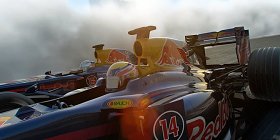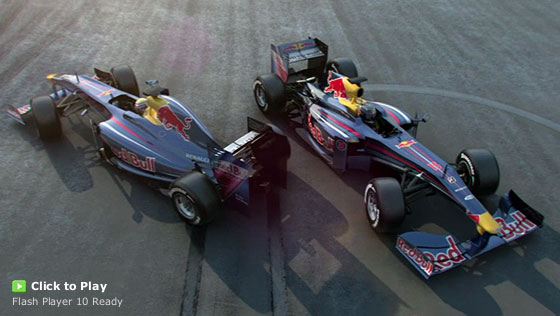|
• Source: 3Dup.com - The Computer Graphics Portal • URL: http://3dup.com/news/view.vfx?nid=138 • Category: Miscellaneous
3 Videos from Peter Clausen Film and TV Productions. Cinema 4D Helps Explaining the Most Sweeping Changes in the F1 History
3Dup.com - April 22, 2009 - 21:25
 For the 2009 season Formula 1 has seen one of the most sweeping changes in the sport's history. The new regulations significantly change how the cars look and behave and affect everything from aerodynamics to tires. Additionally, one of the most innovative additions to the cars has been made with the new KERS powertrain. It recovers wasted kinetic energy generated under breaking and stores it in a battery. Using that stored energy, the driver can boost the performance of his car by approximately 80 horse power for up to six-and-a-half seconds.
For the 2009 season Formula 1 has seen one of the most sweeping changes in the sport's history. The new regulations significantly change how the cars look and behave and affect everything from aerodynamics to tires. Additionally, one of the most innovative additions to the cars has been made with the new KERS powertrain. It recovers wasted kinetic energy generated under breaking and stores it in a battery. Using that stored energy, the driver can boost the performance of his car by approximately 80 horse power for up to six-and-a-half seconds. After the success of the Singapore "Let's do a lap" film, Red Bull Racing trusted Peter Clausen Film & TV (Munich, Germany) once again with the production of an explanatory film showcasing the rule changes and their effect on the race. The basic idea of the film is to show the assembly of the previous season's car and then transform it to meet the 2009 season regulations. While the content of the film should supply all the information about the new rules it was also supposed to be a fun and entertaining ride. To follow the well-proven partnership in production of full CG films, Peter Clausen Film & TV commissioned AixSponza Animation and VFX (Munich, Germany) to complete all 3D work. Even in the very early stages of storyboarding it was quite clear that, due to the number of special effect shots, using live footage was not a feasible way to go. Hence, the best solution was to produce the entire film as a fully computer generated piece. After the production of Singapore "Let's do a lap" a lot of techniques and assets for a car racing animation were already in place, so a lot more time could be spent on making things look even better this time around. The basic workflow was kept the same using Cinema 4D as the principal 3D application and Vray as the renderer for all beauty passes. Enhancements were made in the details of the workflow, most notably in adjusting the rigging of the car to better accommodate revisions in the cars' geometry or texturing.  After storyboarding was completed there were about six weeks left to produce 110 seconds of animation. A lot of time went into research and development on how to do complex transformations of car parts to highlight the changes to the aerodynamics of the car. Another team of artists simultaneously worked on the setup of a functioning Formula 1 engine, which was going to be used in the explanation of the KERS powertrain. At the end of that process an easy to use yet technically correct setup of morphing cars and a running engine could be handed over to the animators - all coded in XPresso and controlled by only a few User Data sliders. The production of "Rip Through the Rule Book" began even before the real car was finished, so a lot of details such as the position of advertising partners' stickers kept changing. As the rigging of the car got more and more complex over time (with the whole character rig of the drivers being controlled by it, as well as secondary animation and manual overrides), we needed an easy-to-use and fast system to apply the rig to revisions of car geometry and textures. Once again, Cinema 4D's XPresso in conjunction with custom User Data solved the problem for us. All the animation controls were put on a separate NullObject that could be easily linked to any car present in a scene, thus making it a two-second job to switch the car with a newer version.  "During the production of this animation we came to appreciate XPresso even more than we already did. Without the presence of a such well-integrated node-based scripting language that can control each and every function in Cinema 4D, this project would have been virtually impossible to do" says Manuel Casasola Merkle, managing director of AixSponza. "XPresso offers unsurpassed access to all areas of the program and offers us the possibility to give every artist just what he or she needs. Animators get clean User Data for animation, the CAD team can build up the car geometry without having to worry about the rigging and TDs are able to delve into mathematics without having to worry how to apply revised shaders. That is true flexibility." For the environment, AixSponza's procedural racetrack building kit was used once again. Relying entirely on MoGraph and some proprietary tools, all shapes of a racetrack can be built by simply adding or removing single objects like curbs, concrete walls, railings and so on. The shapes of the tracks are all based on Splines. Therefore, using MoGraph to furnish the track is a simple, reliable and stable method of building complex surroundings for the cars. Parallel to the creation of assets and technical setups, director Peter Clausen and co-director Christian Tyroller, along with the animation team, started to build and refine the animatics. Extra care was taken to get the cameras just right to show transformations, morphs and special effects in all their glory. Once that process was finished and all assets were ready, the production began. A critical part of production was the quality of the renderings. A lot of different effects had to be seamlessly integrated, ranging from photorealistic beauty passes to sfx passes like the glowing KERS and vfx passes like dynamic smoke. Luckily enough Cinema 4D offers a lot when it comes to rendering. With the Advanced Render module we were able to render all kinds of masks, volumetric lights, ambient occlusion, motion vector and z-depth passes at unparalleled speed and quality, while the flawless integration of third-party render engines like Vray made it possible to get beauty passes just right with advanced global illumination and shading. In Vray we once again relied on the rock-solid combination of brute force for the primary bounce and light cache for the secondary one. This gave us stable GI renderings with crisp shadows at relatively fast render times. In conjunction with AixSponza's rather extensive NET farm final outputs could be delivered quickly with an average render time of only 20 minutes per frame. One of the main visual effects that had to be included in the film was a lot of dynamic smoke emitted by the tires during the skidding sequence, when the car accelerates and when groove tires are switched to slicks. Third-party applications were used to create the smoke coming from the tires. Part of the effect shots (namely the big smoke cloud of the engine blowup sequence) was outsourced to Pixellusion VFX (Cologne, Germany). All other smoke was done in-house at AixSponza. "Fortunately Cinema 4D offers advanced functionality for baking even the most complex rigs. No matter if there are loads of expressions, joints and constraints, you simply throw it at the baker and half a minute later you've got perfect keyframes for everything", says Matthias Zabiegly, VFX artist at AixSponza. "We used the FBX exporter to easily port our animated Formula 1 cars to an external application which we used to generate smoke passes that perfectly matched on top of the beauty passes." Using AfterEffects as our main compositing tool we were able to take advantage of Cinema 4D's option to export AfterEffects project files, which contain 3D cameras and Null-references. Being able to export such information made compositing a whole lot easier as there was no need for tracking anymore. Things like roto masks, lens flares or focal points could simply be attached to exported 3D data. Final color grading was also done in After Effects as the compositing project was already set up, giving easy access to all the various layers and masks. Depth-of-Field and motion blur was added in post production, which offered a lot more control over the effect. More Information at www.maxon.net. Image and Videos Courtesy of Peter Clausen mBH |